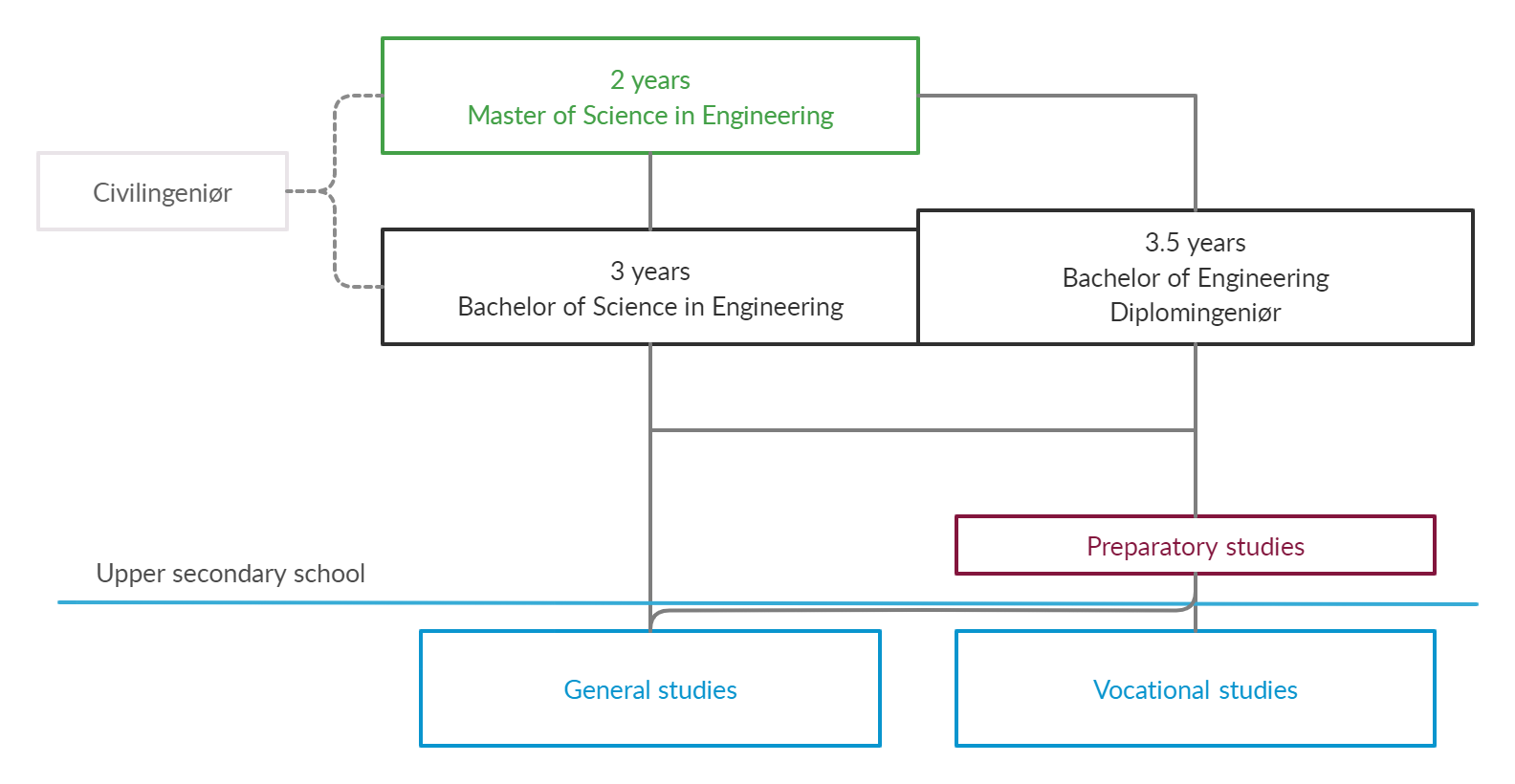DENMARK
In Denmark, there are more than 150 engineering programs in 13 different campuses across nine different cities. Most programs are taught in Danish, but some programs are available in English. The engineering education has two paths:
Diplomingeniør (Bachelor of Engineering), a 3.5-year study, practical oriented program.
Civilingeniør (Bachelor/Master of Science in Engineering), consisting of 3-year bachelor programs and 2-year master programs.
The bachelor programs are BSc or BEng, where the Bachelor of Engineering degree is academically equal to the Bachelor of Science. It is also possible to complete an Industrial Master of Science degree, e.g. in Engineering in Operations Management and Software Engineering.

Civilingeniør
The civilingeniør programs consist of a 3-year bachelor program and 2-year master program. The universities that offer civilingeniør programs are DTU: Danmarks Tekniske Universitet, Aarhus University, VIA University College (bachelor only) and SDU: Syddansk Universitet. The universities offer a wide variety of different programs, from biotech to design and innovation.
Diplomingeniør
The universities that offer diplomingeniør programs are DTU: Danmarks Tekniske Universitet, Aalborg University, Aarhus University, SDU: Syddansk Universitet and Absalon University College. These programs are practical oriented and take 3.5 years (7 semesters). The sixth semester is a work-placement (internship) in a relevant industrial firm and the seventh semester is dedicated to a final project in cooperation with the relevant industry.
Application and preparation
There are both general and specific requirements for applying. Different programs have different specific requirements, but a general rule is for students to have good knowledge of physics, chemistry and mathematics. For engineering programs, the general requirements are:
Upper secondary school leaving certificate or equivalent
An admission course for engineering programs
Most universities offer an admission course, running from a couple of weeks to 1.5 years depending on the amount of supplying needed. The shorter courses are students who might need more knowledge in one subject while the longer courses are students who finished a primary school exam and have years of practical work or have a vocational education.
The required subject levels in the majority of civilingeniør programs are:
Danish A (is replaced with native language on equivalent level for Nordic students)
English B
Mathematics A
Physics B and/or Chemistry C
The required subject levels in the majority of diplomingeniør programs are:
Mathematics A
Physics B
Chemistry C and/or English B
The upper secondary education programs that offer the necessary subject levels are STX and HTX programs, so these are the optimal programs for students aiming for engineering programs at university level.
For master programs, the application requirements are a recognised bachelor's degree of good standard or equivalent and proof of good English skills if the program is taught in English and good Danish skills if the program is taught in Danish (for non-Danish citizens).
Applications are digital and go through the same website for every university. There are two entry quotas for applicants. Most applicants are admitted through quota 1 where they are assessed on a matriculation exam. In quota 2, applicants are admitted with a different admission basis than a matriculation exam (admission course) or if they have additional qualifications, they would like to be assessed on. The application requirements for quota 2 are set by each university. Universities determine the number of quota 2 places available in their programs.
Programs only have a certain amount of study places available, so meeting the requirements does not necessarily guarantee a study place. If there are more quota 1 applicants than quota 1 study places available, applicants are ranked based on the grade point average in their upper secondary school leaving certificate. If there are more quota 2 applicants than quota 2 study places available, applicants are ranked based on the quota 2 application criteria set by each university.
It is possible to apply for multiple programs at once in case admission for some program is not granted. The applications are ranked by students' preferences. Students are only offered one study place, which will be the highest placed program on their list of preferences that the student has been accepted into.